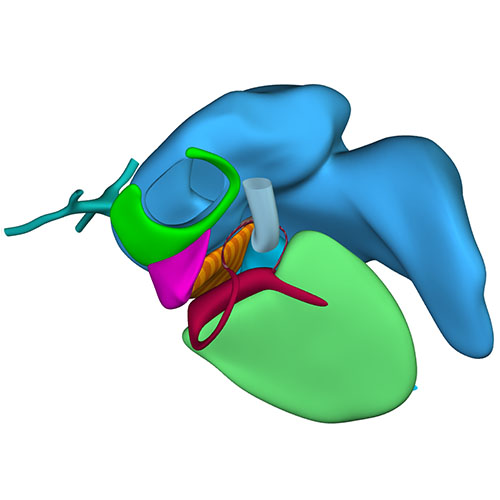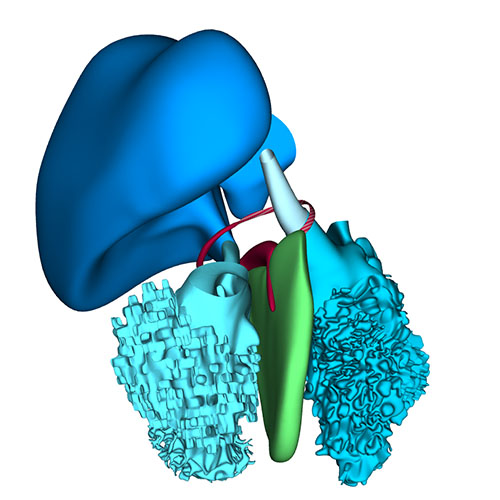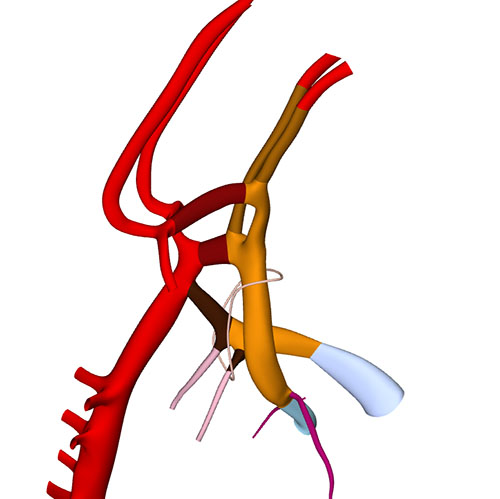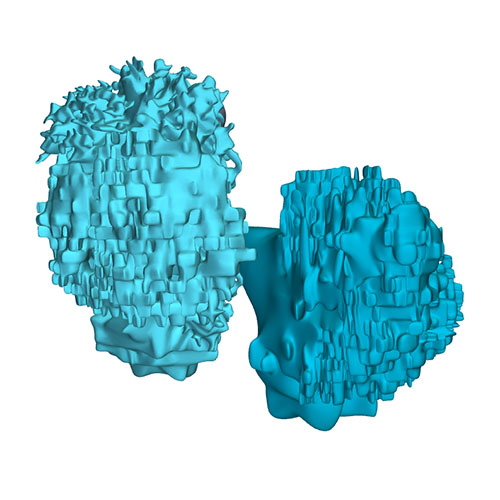
Back |
Interactive 3D PDF of Carnegie Stage 20 |
The interactive PDF below has been very kindly provided by Dr. Jill PJM Hikspoors, Prof. Wouter H Lamers,
Department of Anatomy & Embryology, Maastricht University, Maastricht, The Netherlands
Contact: jill.hikspoors@maastrichtuniversity.nl
Publication: 10.1038/s42003-022-03153-x
*Important* Although some web browsers will allow PDFs to be viewed online, the file must be downloaded and saved to a computer to enable the interactive options.
 |
 |
 |
||
Right-sided view |
Right sagittal view: Visualizing secondary foramen. Indermediate part of the interventricular foramen is closed |
Cranial view: Tricuspid gully and subaortic part remain, while intermediate part of interventricular foramen is closed |
||
 |
 |
 |
||
Right view: Aorta and pulmonary trunk with arterious duct |
Left cranial view: Adjacent and non-adjacent leaflet formation |
Caudal view: Changing position of the right ventricle |
For stages 19 through 23, Streeter changed his staging system from one based on qualitative morphological criteria to one based on a more quantitative assessment of organ development. With fewer features changed qualitatively, we have reconstructed only 2 stages. Stage 20 is reached when ~49 days have passed since conception. Compared to CS18, only limited differences in the venous part of the heart are seen. The caudal part of the left cardinal, or hemiazygos, vein has disappeared. The atrial appendages have become prominent cranioventral extensions, with the appendages still being similar in size. The stem of the pulmonary veins has further increased in diameter, with its first division now having acquired a myocardial wall. The myocardial atrioventricular canal still resembles a very shallow funnel, in which superior and inferior atrioventricular cushions are no longer separately distinguishable. Hence, they are depicted as hatched in the reconstruction. The left ventricle has now acquired a thick compact myocardial wall and, concomitantly, a pronounced ventrally pointing apex, while the thinner-walled right ventricle has mainly enlarged radially, extending more forward or cranially than the left ventricle.
The middle part of the tripartite interventricular foramen, which was located between the crest of the muscular ventricular septum, the rightward margins of the atrioventricular cushions, and the myocardializing ventricular end of the parietal outflow ridge, has now closed. Closure is brought about by extension of the right-sided margins of the endocardial cushions towards the muscularizing proximal outflow ridges. The newly formed septum does not myocardialize. It is known, therefore, as the membranous ventricular septum. The position of the GlN ring identifies the borders of the two persisting parts of the initial interventricular foramen. Of these, the right atrioventricular junction now occupies a near-frontal plane between the ventricular septal crest medially and the atrioventricular junction laterally, while the left ventricular outlet and the subaortic channel follow a more oblique course between the crest of the ventricular septum and the inner curvature of the heart. Myocardialization of the fused proximal ridges has progressed further distally towards the arterial roots. The valvar leaflets have become longer and thinner, with the aortic and pulmonary parts separated by the remaining distal part of the neural-crest whorl. The arterial walls of the valvar sinuses are beginning to form. The left and right semilunar leaflets of both arterial valves remain within the persisting collar of outflow tract myocardium. Distal to the developing sinutubular junction, the walls of the ascending aorta and pulmonary trunk have an arterial phenotype. The right-sided dorsal aorta, which was still identifiable as a rudimentary vessel at CS19, has disappeared at CS20.
Click an image to download a 3D-PDF. The file must be saved to a computer to enable the interactive options. The 3D-PDFs can be opened on any computer as long as Adobe PDF or equivalent reader is installed.
A 3D-PDF becomes activated by “clicking” with the mouse on the reconstruction.
A toolbar appears at the top of the screen that includes the option “model tree”.
The model tree displays a material list of structures in the upper box, and preset viewing options (cameras) in the lower box. The sequence of items corresponds to that in Supplemental Table 3 of the publication.
The list of visible structures can be modified by marking or unmarking a structure.
To manipulate the reconstruction, press the left mouse button to rotate it, the scroll button to zoom in or out, and the left and right mouse buttons simultaneously to move the embryo across the screen.
A structure can be rendered transparent by selecting that option from the drop-down menu after selecting the structure with the right mouse button.
To inspect a combination of structures, one is advised to build up the composition, beginning with a familiar component, such as a lumen, rather than deleting non-relevant structures one-by-one from a completely reconstructed specimen.
The slicer button in the toolbar allows making cross sections. The plane of section can be adjusted with the offset and tilt options.
The “loop wires” in Supplemental Figures 3-6 of the publication, which are drawn through the center of the endocardial heart tube, emphasize the changing shape of the heart loop during CS10-13.
The side length of the scale cubes is 200 μm.
The preset views correspond to the images shown in Figures 1-10 of the publication.
Note that items that are visible in these views can be altered by marking or unmarking a structure in the model tree.